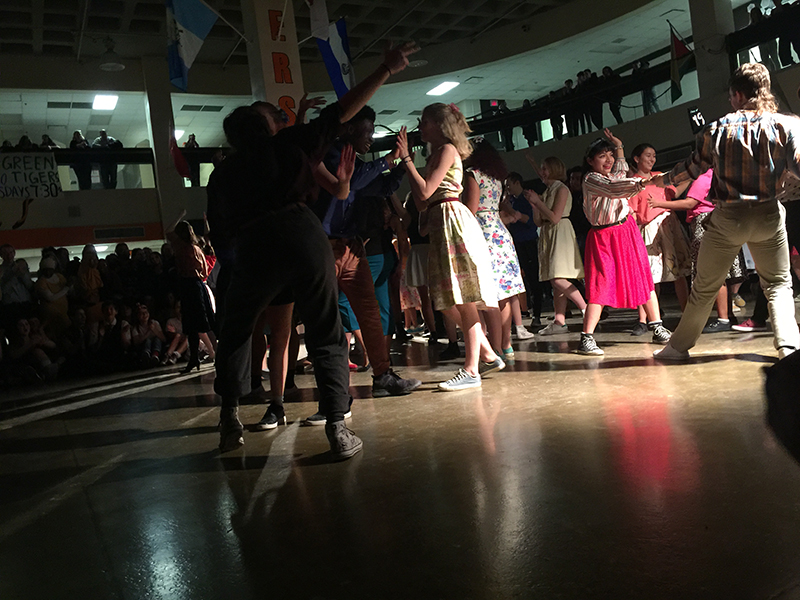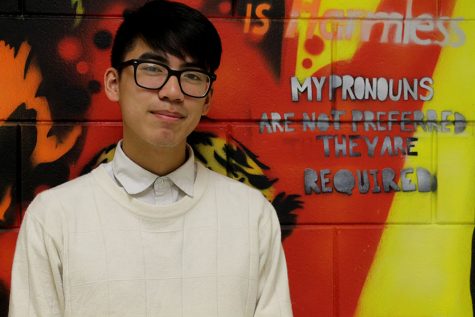What Swing Night means to South
January 22, 2019
Bright lights coloring the drab commons. Tasteful delicacies lining the lunch tables, served by none other than alumni, parents, and faculty. Shiny marbles and flower petals strewn across the tables draped in red. Students from every part of the school—from the shy freshman exploring South High’s social events to the outgoing senior who’s attended them all—dancing tirelessly in their fanciest attire. Performers—from jazz band musicians to company dancers—fill every corner of the commons with the undying passion for swing.
Once a year, we—as a school—have the pleasure of hosting and attending Swing Night. From the profound talents comprising the music department to the invaluable joy of students, parents, and teachers alike who attend, Swing Night is one of many cherished traditions at South High.
“Swing Night is all about social dancing,” South High senior Sydney Miller explained. “It’s a special night where we can dance to live music and older music, especially since swing dancing isn’t accessible to everyone.”
Although the tradition of Swing Night seems timeless, the surprising truth is that Swing Night is no older than the seniors who will walk the stage this year. “The first [Swing Night] happened my freshman year.” South High senior Natashia Otiso said.
Miller and Otiso both attended Swing Night for every one of the four years since Swing Night’s inception. This year, Miller performed pieces such as “Anitra’s Dance” and “Pennsylvania 6-5000” with Jazz 1, while Otiso performed choreographed swing dance with Dance Company 2 and sung “Fine and Mellow” by Billie Holiday alongside Jazz 1.
“Before we had Swing Night, we had a Singer’s Showcase,” Otiso explained. “Which was like Swing Night, but there wasn’t a social dance.”
Over time, the Singer’s Showcase grew to be bigger and better. Eventually, nearly every corner of the music and dance departments joined together to form what we know now as Swing Night.
“Seeing how Swing Night has developed into all of the music programs getting to bond and collaborate together is just really special for me,” Miller said. “Swing Night started out as just Jazz 1, but now it includes Jazz 2, both dance companies, the community band, and the pop singers.”
For musicians at South High, Swing Night is one of few occasions where the entire department can come together to perform. “South’s music is really strong, but events like these make it stronger,” Miller expressed. “[Swing Night] allows the community to see us as both one single program and many programs that build that program.”
“[Swing Night] also lets music students explore other kinds of music and other kinds of art expression that help us become greater musicians.” Miller concluded.
“You see your friends perform in concerts, but you don’t actually get to see them and dance while they’re performing.” South High senior Siobhan Sullivan said. Sullivan is a singer in Pop Singers and the vice president of Chamber Orchestra, where she plays violin.
For company dancers, Swing Night is nonetheless exciting. “We often host guest performers, so—as a dancer—you get to connect with different guests and work with different professionals.” South High senior and Dance Company 2 performer Li Cuff said.
This year, the dance department worked with guest artists Peter Strom and Naomi Uyama—two world-famous swing dancers specializing in the Lindy Hop dance—to learn swing dance and choreograph the various dance pieces seen at Swing Night.
“[Peter and Naomi] go around and teach people how to do the classic Lindy Hop dance,” Otiso said. “They teach classes at a studio, and they were traveling while they were teaching us. At one point, they were in Britain.”
According to Otiso, the Lindy Hop emerged from a generation of African-Americans during the Harlem Renaissance. Nearly a century after the dance’s inception, the dance is still being taught, although with somewhat of a disconnect to the dance’s black roots.
“[Peter and Naomi] think it’s important to preserve the dance form because a lot of dance forms have been appropriated or taken away from their roots,” Otiso said. “There aren’t a lot of people who do [swing dance] and a lot of people who do [swing dance] are white.”
While Swing Night may be the most coveted performance of the year by musicians and dancers alike, the event is no less thrilling for those attending. Every year, Swing Night garners incredible turnout from every corner of South High: students, parents, family members, teachers, faculty, everyone.
Being that swing dance isn’t commonly taught in the city, Peter and Naomi taught an introductory swing dancing lesson at the beginning of Swing Night. From rock steps to complex turns, Peter and Naomi helped everyone get off on the right foot (no pun intended) to tackle a night filled with dance.
“I think it’s nice that high schoolers are getting this opportunity to social dance and to be at a dance where people aren’t fist-pumping to ‘Mo Bamba’ and sweating on each other.” Otiso said.
Although Swing Night might be classified as a school dance, many students are quick to distinguish Swing Night from other dances such as Homecoming and Prom. “A lot of people that you wouldn’t expect to go do go, because [Swing Night] is so exciting and different from other dances.” Otiso said.
At Swing Night, there are looser standards for formal dress and less expectations for what a school dance should be. “[Swing Night] is like a school dance, but it’s a lot more comfortable.” Cuff explained. “Everyone is there having a good time; it’s nothing too formal.”
Moreover, an emphasis on real dancing and live music is what some students are looking for. “[Other dances] play different kinds of music that mostly involve people jumping,” Sullivan said. “I really like learning swing dance, and I really enjoy that kind of dance more.”
Compared to other school dances with ticket prices ranging from $30 to $50, Swing Night is a much more accessible school dance with ticket prices at $5. For students and adults alike, the price difference matters a lot.
Although Swing Night has been a South High tradition for only four years, the dance has quickly found home within the musicians, who learn and perform classic jazz pieces; the dancers, who carry on the timeless traditions of swing dance; the administration and technical crew, who maintain the dance every year without fault; and, of course, South High, whose remarkable attendance every year is an indisputable reminder of the unbreakable bonds that comprise our school.
For many classes of students to come, Swing Night will continue to be one of the strongest celebrations of our unity as a school. Although Swing Night may be unrecognizable from its early beginnings in the Singer’s Showcase, our school will never forget the energetic dances and unforgettable songs that bring us together once a year.
“I can’t imagine going to South High without Swing Night.” Otiso concluded, reflecting on the past four years of high school. “I’m going to miss Swing Night.”







